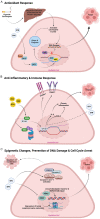Mechanistic review of sulforaphane as a chemoprotective agent in bladder cancer
- PMID: 37168941
- PMCID: PMC10165231
Mechanistic review of sulforaphane as a chemoprotective agent in bladder cancer
Abstract
Regular consumption of cruciferous vegetables has numerous health benefits, including reduced cancer risk and improved patient outcomes. Sulforaphane (SFN) is an isothiocyanate found in cruciferous vegetables with a chemoprotective role against epithelial cancers, particularly of the bladder. Epithelial cells have several functions, including secretion, absorption, filtration, and protection from environmental insults. The specialized stratified epithelium of the bladder has direct and frequent contact with carcinogenic agents, increasing the likelihood of cancer initiation at this site. Carcinogen exposure, particularly from cigarette smoke or occupational exposure to aromatic amines, are the most significant risk factors for bladder cancer due to their ability to activate inflammatory pathways, induce free radicals, and damage DNA. SFN acts as an antioxidant by activating phase II enzymes involved in carcinogen detoxification to prevent DNA damage and inhibit tumor initiation, modulates multiple signaling pathways to inhibit tumor growth and progression, and has anti-inflammatory and immune-modulating properties to help protect against cancer. Due to these chemoprotective mechanisms, SFN has been studied as both mono- and adjuvant therapy in several bladder cancer models. Here we present a review of the effects of SFN on carcinogen-induced bladder cancer to support the inclusion of cruciferous vegetables as a chemoprotective strategy.
Keywords: Sulforaphane; bladder; cancer; carcinogen; isothiocyanate.
AJCEU Copyright © 2023.
Conflict of interest statement
None.
Figures

References
-
- Cancer stat facts: bladder cancer. seer.cancer.gov: NIH - National Cancer Institute
-
- Key statistics for bladder cancer. cancer.org: American Cancer Society. 2021
-
- Apolo A, Dahut W. The Bethesda Handbook of Clinical Oncology. Philadelphia, PA 19106: Lippincott Williams & Wilkins; 2014.
Publication types
LinkOut - more resources
Full Text Sources
Research Materials
Miscellaneous
